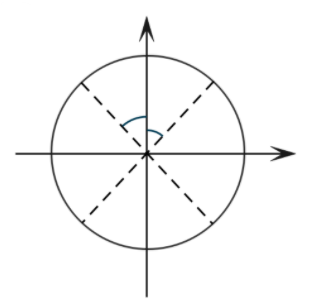
Answer
425.4k+ views
Hint: In the above question, we were told that the radius of the circle is very large than the dipole size. Therefore, we can confirm the circle is equipotential. Next, the net electric field should always be perpendicular to the surface. The electric field at point B along the tangent must be equal to zero.
Complete answer:
Let us write down the given terms and quantities,
$P = \dfrac{{{p_0}}}{{\sqrt 2 }}(i + j)$.
The electric field at point b along the tangent will be equal to zero as the circle is confirmed as equipotential.
Therefore,
$\eqalign{
& {E_0} = \dfrac{{K|P|}}{{{R^3}}},{E_B} = 0 \cr
& \Rightarrow {R^3} = \dfrac{{K{P_0}}}{{{E_0}}} \cr
& \Rightarrow {R^3} = (\dfrac{{{P_0}}}{{4\pi {\varepsilon _0}{E_0}}}) \cr
& \therefore R = {(\dfrac{{{P_0}}}{{4\pi {\varepsilon _0}{E_0}}})^{\dfrac{1}{3}}} \cr} $
It is clear that option c is correct.
The electric field ${E_0}$ is uniform. Due to the presence of dipole, the electric field at different points is different.
Hence, the total electric field will be different at different points. Option a is incorrect.
The electric field at point A ell be,
${E_A} = \dfrac{{2KP}}{{{R^3}}} + \dfrac{{KP}}{{{R^3}}} = 3\dfrac{{KP}}{{{R^3}}}\dfrac{{{P_0}}}{{\sqrt 2 }}(i + j)$
Hence, option b is incorrect.
As discussed earlier, the electric field at point B is zero as the circle is equipotential.
Hence, the correct options are option c and d.
Additional information:
An electric dipole is a pair of equal and opposite point charges -q and q, separated by a distance 2a. The direction from q to -q is said to be the direction of the dipole. The electric dipole moment is a measure of the separation of the positive and negative electric charge within a system, that is, a measure of the system's overall polarity. SI units of the dipole moment are coulomb meter. In atomic physics and chemistry, we use a common unit called Debye.
Note:
The angle involved in the electric dipole is defined with respect to the electric field lines. Most of us assume that the angler involved in the electric dipole is defined with respect to equipotential lines. Dimensional analysis also should be taken care of during the calculations.
Complete answer:
Let us write down the given terms and quantities,
$P = \dfrac{{{p_0}}}{{\sqrt 2 }}(i + j)$.
The electric field at point b along the tangent will be equal to zero as the circle is confirmed as equipotential.
Therefore,
$\eqalign{
& {E_0} = \dfrac{{K|P|}}{{{R^3}}},{E_B} = 0 \cr
& \Rightarrow {R^3} = \dfrac{{K{P_0}}}{{{E_0}}} \cr
& \Rightarrow {R^3} = (\dfrac{{{P_0}}}{{4\pi {\varepsilon _0}{E_0}}}) \cr
& \therefore R = {(\dfrac{{{P_0}}}{{4\pi {\varepsilon _0}{E_0}}})^{\dfrac{1}{3}}} \cr} $
It is clear that option c is correct.
The electric field ${E_0}$ is uniform. Due to the presence of dipole, the electric field at different points is different.
Hence, the total electric field will be different at different points. Option a is incorrect.
The electric field at point A ell be,
${E_A} = \dfrac{{2KP}}{{{R^3}}} + \dfrac{{KP}}{{{R^3}}} = 3\dfrac{{KP}}{{{R^3}}}\dfrac{{{P_0}}}{{\sqrt 2 }}(i + j)$
Hence, option b is incorrect.
As discussed earlier, the electric field at point B is zero as the circle is equipotential.
Hence, the correct options are option c and d.
Additional information:
An electric dipole is a pair of equal and opposite point charges -q and q, separated by a distance 2a. The direction from q to -q is said to be the direction of the dipole. The electric dipole moment is a measure of the separation of the positive and negative electric charge within a system, that is, a measure of the system's overall polarity. SI units of the dipole moment are coulomb meter. In atomic physics and chemistry, we use a common unit called Debye.
Note:
The angle involved in the electric dipole is defined with respect to the electric field lines. Most of us assume that the angler involved in the electric dipole is defined with respect to equipotential lines. Dimensional analysis also should be taken care of during the calculations.
Recently Updated Pages
How many sigma and pi bonds are present in HCequiv class 11 chemistry CBSE

Mark and label the given geoinformation on the outline class 11 social science CBSE

When people say No pun intended what does that mea class 8 english CBSE

Name the states which share their boundary with Indias class 9 social science CBSE

Give an account of the Northern Plains of India class 9 social science CBSE

Change the following sentences into negative and interrogative class 10 english CBSE

Trending doubts
Fill the blanks with the suitable prepositions 1 The class 9 english CBSE

Which are the Top 10 Largest Countries of the World?

Give 10 examples for herbs , shrubs , climbers , creepers

Difference Between Plant Cell and Animal Cell

Difference between Prokaryotic cell and Eukaryotic class 11 biology CBSE

The Equation xxx + 2 is Satisfied when x is Equal to Class 10 Maths

Change the following sentences into negative and interrogative class 10 english CBSE

How do you graph the function fx 4x class 9 maths CBSE

Write a letter to the principal requesting him to grant class 10 english CBSE




